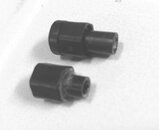Thanks Couv,
So, for the high pressure chamber, garden hose seal, should I use the red o-ring in my pic?
I figured those extra little o-ring are for the LP ports bolts.
The kit doesn't have the o-ring for the HP ports though.
The piston stem seal high durometer -010 seal, is the red color little o-ring I placed with the brass tool on top left correct? My old one is black, just saying.
I will read the file tonight.
Thanks Couv
So, for the high pressure chamber, garden hose seal, should I use the red o-ring in my pic?
I figured those extra little o-ring are for the LP ports bolts.
The kit doesn't have the o-ring for the HP ports though.
The piston stem seal high durometer -010 seal, is the red color little o-ring I placed with the brass tool on top left correct? My old one is black, just saying.
I will read the file tonight.
Thanks Couv






